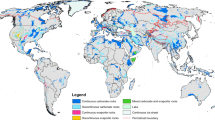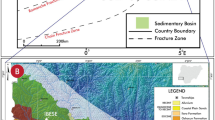Abstract
We investigated major ions, stable isotopes, and radiocarbon dates in a Quaternary aquifer in semi-arid northwestern China to gain insights into groundwater recharge and evolution. Most deep and shallow groundwater in the Helan Mountains was fresh, with total dissolved solids <1,000 mg L−1 and Cl− <250 mg L−1. The relationships of major ions with Cl− suggest strong dissolution of evaporites. However, dissolution of carbonates, albite weathering, and ion exchange are also the major groundwater process in Jilantai basin. The shallow desert groundwater is enriched in δ18O and intercepts the local meteoric water line at δ18O = −13.4 ‰, indicating that direct infiltration is a minor recharge source. The isotope compositions in intermediate confined aquifers resemble those of shallow unconfined groundwater, revealing that upward recharge from intermediate formations is a major source of shallow groundwater in the plains and desert. The estimated residence time of 10.0 kyr at one desert site, indicating that some replenishment of desert aquifers occurred in the late Pleistocene and early Holocene with a wetter and colder climate than at present.









Similar content being viewed by others
References
Allison GB, Gee GW, Tyler SW (1994) Vadose-zone techniques for estimating groundwater recharge in arid and semiarid regions. Soil Sci Soc Am J 58(1):6–14
Cartwright I, Weaver TR (2005) Hydrogeochemistry of the Goulburn Valley region of the Murray Basin, Australia: implications for flow paths and resource vulnerability. Hydrogeol J 13(5–6):752–770
Chen J, Wang F, Xia X, Zhang L (2002) Major element chemistry of the Changjiang (Yangtze River). Chem Geol 187(3):231–255
Chen ZY, Qi JX, Xu JM, Ye H, Nan YJ (2003) Paleoclimatic interpretation of the past 30 ka from isotopic studies of the deep confined aquifer of the North China plain. Appl Geochem 18(7):997–1009
Chen FH, Fan YX, Chun X, Madsen DB, Oviatt CG, Zhao H, Yang LP, Sun Y (2008) Preliminary research on the Megalake Jilantai-Hetao in Late Quaternary. Chin Sci Bull 53(11):1725–1739
Chen J, Liu X, Wang C et al (2012) Isotopic constraints on the origin of groundwater in the Ordos Basin of northern China. Environ Earth Sci 66(2):505–517
Clark I, Fritz P (1997) Environmental isotopes in hydrogeology. Lewis, New York
Coplen TB, Herczeg AL, Barnes C (2000) Isotope engineering-using stable isotopes of the water molecule to solve practical problems. In: Cook PG, Herzeg AL (eds) Environmental tracers in subsurface hydrology. Kluwer, Boston, pp 79–110
Currell MJ, Cartwright I, Bradley DC, Han DM (2010) Recharge history and controls on groundwater quality in the Yuncheng Basin, north China. J Hydrol 385(1):216–229
Edmunds WM (2003) Renewable and non-renewable groundwater in semi-arid regions. Dev Water Sci 50:265–280
Edmunds WM, Ma J, Aeschbach-Hertig W, Kipfer R, Darbyshire DPF (2006) Groundwater recharge history and hydrogeochemical evolution in the Minqin Basin, North West China. Appl Geochem 21(12):2148–2170
Eichinger E (1983) A contribution to the interpretation of 14C groundwater ages considering the example of partially confined sandstone aquifer. Radiocarbon 25(2):347–356
Evans GV, Otlet RL, Downing A, Monkhouse RA, and Rae G (1979) Some problems in the interpretation of isotope measurements in United Kingdom aquifer. In: Isotope hydrology, vol. 2, pp 639–708. Proceedings of Symposium, Neuherberg, 1978, IAEA-SM228/34
Fan YX, Chen FH, Wei GX, Madsen DB, Oviatt CG, Zhao H, Chun X, Yang LP, Fan TL, Li GQ (2010) Potential water sources for Late Quaternary Megalake Jilantai-Hetao, China, inferred from mollusk shell 87Sr/86Sr ratios. J Paleolimnol 43(3):577–587
Farid I, Trabelsi R, Zouari K et al (2013) Deciphering the interaction between quaternary and continental Sabkhas aquifers in Central Tunisia using hydrochemical and isotopic tools. Environ Earth Sci 70:3289–3309
Fisher RS, Mullican WF (1997) Hydrochemical evolution of sodium-sulfate and sodium-chloride groundwater beneath the northern Chihuahuan Desert, Trans-Pecos, Texas, USA. Hydrogeol J 5(2):4–16
Fontes JC, Gamier JM (1979) Determination of the initial 14C activity of the total dissolved carbon: a review of the existing models and a new approach. Water Resour Res 15(2):399–413
Gates JB, Edmunds WM, Darling WG, Ma J, Pang Z, Young AA (2008) Conceptual model of recharge to southeastern Badain Jaran Desert groundwater and lakes from environmental tracers. Appl Geochem 23(12):3519–3534
Gee GW, Hillel D (1988) Groundwater recharge in arid regions: review and critique of estimation methods. Hydrol Process 2(3):255–266
Geng K, Chen YF (1990) Formation, development and evolution of Jilantai salt-lake, Inner Mongolia. Acta Geogr Sin 45(3):341–349 (in Chinese)
Geng K, Hu CY, Liu J (1989) Quaternary lake evolution in the Jilantai region. J Arid Land Res Environ 3(2):26–33 (in Chinese)
Gibbs RJ (1970) Mechanisms controlling world water chemistry. Science 170(3962):1088–1090
Glynn PD, Plummer LN (2005) Geochemistry and the understanding of groundwater systems. Hydrogeol J 13(1):263–287
Guo HD, Liu H, Wang XY, Shao Y, Sun Y (2000) Subsurface old drainage detection and paleoenvironment analysis using spaceborne radar images in Alxa Plateau. Sci China Ser D 43(4):439–448
Ma J, He J, Q S, Zhu G, Zhao W, Mike Edmunds, Zhao Y (2012) Groundwater recharge and evolution in the Dunhuang Basin, northwestern China. Appl Geochem. http://dx.doi.org/10.1016/j.apgeochem.2012.10.007
Hem JD (1985) Study and interpretation of the chemical characteristics of natural water, Water-Supply Pager 2254, 3rd edn. U.S. Geological Survey, Alexandria, VA
Herczeg AL, Edmunds WM (2000) Inorganic ions as tracers. In: Cook PG, Herzeg AL (eds) Environmental tracers in subsurface hydrology. Kluwer, Boston, pp 31–78
Hill D (1984) Diffusion coefficients of nitrate, chloride, sulphate and water in cracked and uncracked Chalk. J Soil Sci 35(1):27–33
Ingerson E, Pearson FJ Jr (1964) Estimation of age and rate of motion of groundwater by the 14C-method. In: Miyake Y, Koyama T (eds) Recent researches on the fields of atmosphere, hydrosphere, and nuclear geochemistry. Sugawara Festival Volume, Maruzen Co., Tokyo, pp 263–283
Jones BF, Deocampo DM (2003) Geochemistry of Saline Lakes. Treatise Geochem 5:393–424
Kreuzer AM, Rohden CV, Friedrich R, Chen Z, Shi J, Hajdas I, Aeschbach-Hertig W (2009) A record of temperature and monsoon intensity over the past 40 kyr from groundwater in the North China Plain. Chem Geol 259(3):168–180
Liu XQ, Ge WS (2002) Remote sensing interpretation of regional geological characteristics and the formation and evolution of Jilantai salt lake. Oceanol Limnol Sin 33:145–150 (in Chinese)
Ma JZ, Wang XS, Edmunds WM (2005) The characteristics of ground-water resources and their changes under the impacts of human activity in the arid northwest China—a case study of the Shiyang River Basin. J Arid Environ 61(2):277–295
Ma J, Ding Z, Edmunds WM, Gates JB (2009) Limits to recharge of groundwater from Tibetan plateau to the Gobi desert, implications for water management in the mountain front. J Hydrol 364(1):128–141
Mahlknecht J, Schneider JF, Merkel BJ, Navarro LI, Bernasconi SM (2004) Groundwater recharge in a sedimentary basin in semi-arid Mexico. Hydrogeol J 12(5):511–530
Mclean W, Jankowski J, Lavitt N (2000) Groundwater quality and sustainability in an alluvial aquifer, Australia. In: Sililo O (ed) Groundwater: past achievements and future challenges. AA Balkema, Rotterdam, pp 567–573
Ningxia Institute of Geologic Engineering Investigation, Alashan Institute of Water Conservancy Survey and Design (2006) Report on hydrogeological of Alashan regional, Inner Mongolia (in Chinese)
Pang XL, Hu DS (2009) Environment evolution and salt forming process of Jilantai Salt Lake since 22 ka BP. J Desert Res 29:190–199 (in Chinese)
Qian H, Li PY, Wu JH, Zhou YH (2013) Isotopic characteristics of precipitation, surface and ground waters in the Yinchuan plain, Northwest China. Environ Earth Sci 70:57–70
Scanlon BR, Keese KE, Flint AL, Flint LE, Gaye CB, Edmunds WM, Simmers I (2006) Global synthesis of groundwater recharge in semiarid and arid regions. Hydrol Process 20(15):3335–3370
Shen ZL, Zhu WH, Zhong Z (1993) Basic of hydrogeochemistry. Geol Press, Beijing (in Chinese)
Shi Y, Zhang X (1995) The influence of climate changes on the water resources in arid areas of northwest China. Sci China Ser B 25(9):968–977 (in Chinese)
Subyani AM (2004) Use of chloride-mass balance and environmental isotopes for evaluation of groundwater recharge in the alluvial aquifer, Wadi Tharad, west Saudi Arabia. Environ Geol 46(6–7):741–749
Tamers MA (1975) Validity of radiocarbon dates on groundwater. Geophys surv 2(2):217–239
Unit 710 of China People’s Liberation Army (1979) Areal hydrogeological survey report for Jilantai area, pp 20–46 (in Chinese)
Vogel JC, Grootes PM, Mook WG (1970) Isotope fractionation between gaseous and dissolved carbon dioxide. Z Phy 230(3):225–238
Wang L, Xu JH, Qian YP (2001) Statement of research on characteristic and law of the yellow river flow and sediment. In: Liu CM, Chen XG (eds) Evolving law and maintaining mechanism of renewable capacity of water resources in the Yellow River Basin. The Yellow River Water Conservancy Press, Zhengzhou, pp 153–158 (in Chinese)
Wang X, Dong Z, Yan P, Zhang J, Qian G (2005) Wind energy environments and dunefield activity in the Chinese deserts. Geomorphology 65(1):33–48
Wilson JL, Guan H (2004) Mountain-block hydrology and mountain-front recharge. Groundwater recharge in a desert environment: the Southwestern United States. Water Sci Appl Ser 9:113–137
Xu H, Hou Z, An Z, Liu X, Dong J (2010) Major ion chemistry of waters in Lake Qinghai catchments, NE Qinghai-Tibet plateau, China. Quat Int 212(1):35–43
Yang X (2006) Chemistry and late quaternary evolution of ground and surface waters in the area of Yabulai Mountains, Western Inner Mongolia, China. Catena 66(1):135–144
Yang LP (2008) Reconstruction of Paleo-Megalake “Jilantai-Hetao” based on remote sensing and DEM. [PhD thesis]. Lanzhou University, China (in Chinese)
Yang LP, Chen FH, Chun X, Fan YX, Sun Y, Madsen DB, Zhang XQ (2008) The Jartai Salt Lake shorelines in northwestern dryland China revealed by remote sensing images. J Arid Environ 53(11):1725–1739
Zhai YZ, Wang JS, Teng YG, Zuo R (2013) Hydrogeochemical and isotopic evidence of groundwater evolution and recharge in aquifers in Beijing Plain, China. Environ Earth Sci 69:2167–2177
Zhu GF, Li ZZ, Su YH, Ma JZ, Zhang YY (2007) Hydrogeochemical and isotope evidence of groundwater evolution and recharge in Minqin Basin, Northwest China. J Hydrol 333(2):239–251
Acknowledgments
This research was supported by the National Natural Science Foundation of China (Nos. 41271039 and 41172163), the Fundamental Research Funds for the Central Universities, and the Key grant Project of the Chinese Ministry of Education (No. 310005). This work also forms part of the 111 project (No. B06026), the wider UK-China research collaboration, the program for New Century Excellent Talents in University (No. NCET-12-0251), and the Fundamental Research Funds for the Central Universities (Grant No. lzujbky-2013-k17). We thank Xifen Zhu, Jianhua He, Xiang Xu, Can Ma and Jingfang Wang for their assistance with our field work and laboratory analysis.
Author information
Authors and Affiliations
Corresponding author
Rights and permissions
About this article
Cite this article
Wei, G., Chen, F., Ma, J. et al. Groundwater recharge and evolution of water quality in China’s Jilantai Basin based on hydrogeochemical and isotopic evidence. Environ Earth Sci 72, 3491–3506 (2014). https://doi.org/10.1007/s12665-014-3257-y
Received:
Accepted:
Published:
Issue Date:
DOI: https://doi.org/10.1007/s12665-014-3257-y




